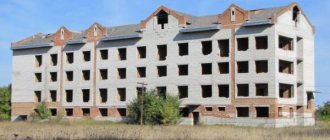One of the promising options for their use is construction, and it is preferable to carry it out on individual housing construction lands.
In addition, such plots have access to the infrastructure of the locality in which they are located, and also, connection to communications occurs at government rates.
We will talk about what such areas are, the features of their use and advantages in this material.
How is this status deciphered and what does it mean?
The abbreviation individual housing construction is found in the text of the administrative document for a land plot, the cadastral passport and the certificate confirming the owner’s rights to the land, so it is important to understand what it is and what it means.
It means an abbreviated name for one of the types of permitted use of a land plot and stands for individual housing construction .
Types of permitted use - hereinafter referred to as VRI, were introduced into the practice of land exploitation by the VRI classifier of land plots, approved by the Ministry of Economic Development of Russia on September 1, 2014, with changes that will become relevant in 2021.
You can read more about the VRI classifier in the article.
A plot with VRI - individual housing construction can be used as follows:
- construction of a low-rise residential building;
- construction of auxiliary outbuildings;
- setting up a garden for your own needs.
At the same time, legislators prohibit the use of land with individual housing construction status for the following purposes:
- construction of houses with several apartments.
- processing of agricultural products as an option for business activities;
- location of municipal and industrial facilities;
- production and sale of products for ritual purposes.
Plots for individual housing construction are located exclusively on the lands of populated areas.
SNT, DNP, individual housing construction - what is it and what is the difference
In order to understand the above terms, the following should be noted. All of them relate to the use of land provided to private individuals. Any piece of land has a specific purpose and cannot be used for other purposes.
When highlighting it, there must be an indication of the type of use permitted for it. For example, it may be indicated that it is allocated for individual housing construction.
This abbreviation stands for individual housing construction.
Such a plot should be used for the construction of a private house suitable for habitation.
The other two abbreviations hide the names of non-profit associations.
They are created for the purpose of organizing the use, disposal, and resolution of various issues regarding country and garden lands. Such associations can be formed in the following forms:
- non-profit partnerships;
- non-profit partnerships;
- consumer cooperatives.
Consequently, the decoding of SNT is a horticultural non-profit association in the form of a partnership. And DNP is a dacha non-profit association in the form of a partnership.
These two associations are legal entities of a non-profit nature. Let's look at the difference between these associations below.
Land selection rules
, the choice of the optimal location of the land
comes into focus .
Each person requires different conditions, but most of them can be summed up under some single criterion.
Let's consider the nuances that need to be taken into account so as not to encounter unpleasant surprises later:
- When planning the construction of a country cottage, look for a site located in close proximity to recreational facilities - ponds, forests.
- For the construction of a permanent residential building, preference should be given to areas located close to social facilities - kindergartens and schools, hospitals and cultural institutions. The presence of markets, as well as stores selling everyday goods, is welcome.
- Convenient access roads making it easy to travel with your own car.
- Availability of utilities or the possibility of promptly connecting them and connecting the house to them.
Owners of plots allocated for individual housing construction have the right to expect proper maintenance of roads , including their winter clearing. The municipality is responsible for this.
What is IJD - Lands of populated areas
- Attic floor (attic)
- a floor in the attic space, the facade of which is fully or partially formed by the surface (surfaces) of a sloping or sloping roof, while the line of intersection of the roof plane and the facade should be at a height of no more than 1.5 m from the floor level of the attic floor.
The letter combination individual housing construction is used quite often, mainly in relation to land plots or houses. For example, the abbreviation individual housing construction can be found in advertisements for the sale of land or a house, as well as when denoting the legal status of land in so-called cottage settlements. What is individual housing construction?
7. DNP plots are often sold from serious companies, from which you can receive significant discounts, gifts, be eligible for promotions and other “amenities” during the purchase and in your future country life. You can also buy plots or houses in installments, including without interest.
Information on the topic: In recent years, the Russian government has periodically raised the issue of allowing residents of the DNP to obtain registration in their home. Of course, the authorities need to resolve a lot of additional problems: assigning police addresses, providing social infrastructure, etc.
You might be interested ==> Everyday Characteristics of a Mentally Disturbed Person
Type of development
Urban planning legislation allows the construction of objects for personal use with a height of no more than three floors .
It can be:
- Residential buildings . Buildings cannot be multi-entrance, designed to accommodate several families or be used for commercial purposes.
- Garages . The same rule applies as in the previous case - a ban on using the object for the purpose of obtaining profit. When placing a building, maintaining a distance from nearby buildings is required. Study the SNiP standards.
- Bathhouse . A fire-hazardous facility requires compliance with fire safety rules during construction. Being an auxiliary structure, it does not require a building permit. Use for commercial purposes is prohibited.
- Other outbuildings – woodsheds, sheds, greenhouses, gazebos. According to the law, buildings of this type must be located deep in the site. Construction must be carried out in compliance with the distances recommended by SNiPs.
A popular construction project - a hotel - can be built on individual housing construction lands if there is appropriate permission from the administrative authority.
Read about what can be built on individual housing construction sites in a separate article.
Land for individual housing construction: pros and cons
Unlike the above associations, land for private construction is always located on the territory of a settlement. The purpose of their provision is the construction of residential private houses.
These houses are permanent in nature and are suitable for year-round use. It is not difficult to register in such houses, and it is easier to connect communications to them. Since such areas are located in or near settlements, there are usually no problems with infrastructure there.
Therefore, such lands are better suited for building a house for permanent residence. True, they cost much more.
The tax paid on property ownership will also be higher in this case.
It is not at all necessary to plant anything on this plot of land. Banks are more willing to take such areas as collateral and provide loans for their purchase.
We are building on a private housing construction site
Individual housing construction requires private developers to comply with certain rules and regulations.
There are restrictions on the area of the plots themselves for construction, the number of floors of houses erected on them, and the location of buildings on the site. Land owners must comply with all requirements of sanitary, fire safety, urban planning and other mandatory standards. In addition, special permits will have to be obtained for the construction of houses. And this requires collecting various documentation, preparing a plan for the site itself, and a scheme for its development.
Failure to comply with these rules may result in various fines being imposed on owners. And houses built without permits are recognized as unauthorized and illegal buildings.
Shaping and Size
When forming a plot allocated for individual housing construction, local self-government bodies are guided by the following conditions:
- presence of unoccupied territories;
- the level of population demand for land plots for construction;
- degree of population of the area;
- assessment of the feasibility of allocating a land plot in accordance with the priority of territory development.
The size of the plot can be from 3 to 30 acres.
It also depends on the area of the future house - there is a requirement for the area allocated for construction - ensuring the free placement of building materials, special vehicles, and auxiliary installations on it.
Type of permitted use
Construction on lands not intended for this purpose is punishable by fines, as well as orders to demolish illegal buildings.
You can clarify the VRI of a specific plot of land by contacting the Rosreestr authorities:
- Order a cadastral passport for the plot. The VRI line, in accordance with the records in the state real estate cadastre, contains information about how the site can be used.
- Cadastral extract about the plot. The Permitted Use line contains the information you are looking for.
You can request data:
- during a personal visit to the Rosreestr authorities or through the website,
- through the MFC,
- State Services website.
In accordance with the current VRI classifier, individual housing construction is indicated in documents as “low-rise residential development” .
For information on how to find out the VRI of a site, read the thematic material at the link.
An administrative act of a local government establishing the VRI of an individual housing construction site can serve as the basis for the start of housing construction work.
Advantages
The undeniable advantages of carrying out construction work on a site for individual housing construction are:
- instant assignment of an address to a built house;
- hassle-free registration at your place of residence ;
- guaranteed provision of all necessary communications;
- close location of social facilities, as well as transport, engineering and utility infrastructure;
- the fee for owning a house is limited to the amount of property tax for individuals;
- the amount of tax on individual housing construction plots is lower than on plots of the same area on agricultural lands and areas allocated for gardening.
- the possibility of obtaining tax deductions for personal income tax for the construction of a house;
- using land as collateral when taking out a mortgage loan;
- receiving maternity capital for a built house.
Hunters will be interested in the possibility of obtaining official permission to store firearms. Houses built on plots with a different VRI do not provide such an advantage to their owner.
Read more about the advantages of individual housing construction in comparison with garden plots in this article, and the differences from private household plots in this article.
What is IJD - Lands of populated areas
The category, together with the intended use of the land, either allows you to legally build your own house on the site for permanent or temporary residence, or prohibits doing so altogether. On a site with the category “land of populated areas”, after the construction of the house is completed, you can get a postal address and register in your new home.
You might be interested ==> Where to Get a Military Mortgage Mortgage Number
From all of the listed types of houses, an individual residential building
has the following type of differences: all load-bearing structures are intended only for it and are, as it were, the personal property of a particular building; it stands on its own foundation and has walls dedicated only to it.







